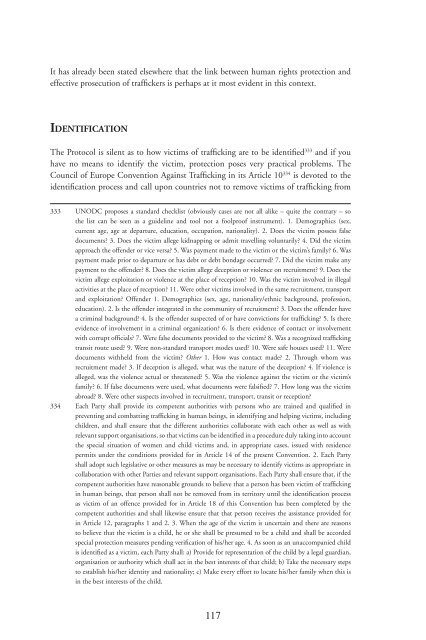Trafficking in human beings: human rights and ... - unesdoc - Unesco
Trafficking in human beings: human rights and ... - unesdoc - Unesco
Trafficking in human beings: human rights and ... - unesdoc - Unesco
You also want an ePaper? Increase the reach of your titles
YUMPU automatically turns print PDFs into web optimized ePapers that Google loves.
It has already been stated elsewhere that the l<strong>in</strong>k between <strong>human</strong> <strong>rights</strong> protection <strong>and</strong><br />
effective prosecution of traffi ckers is perhaps at it most evident <strong>in</strong> this context.<br />
IDENTIFICATION<br />
The Protocol is silent as to how victims of traffi ck<strong>in</strong>g are to be identifi ed 333 <strong>and</strong> if you<br />
have no means to identify the victim, protection poses very practical problems. The<br />
Council of Europe Convention Aga<strong>in</strong>st Traffi ck<strong>in</strong>g <strong>in</strong> its Article 10 334 is devoted to the<br />
identifi cation process <strong>and</strong> call upon countries not to remove victims of traffi ck<strong>in</strong>g from<br />
333 UNODC proposes a st<strong>and</strong>ard checklist (obviously cases are not all alike – quite the contrary – so<br />
the list can be seen as a guidel<strong>in</strong>e <strong>and</strong> tool not a foolproof <strong>in</strong>strument). 1. Demographics (sex,<br />
current age, age at departure, education, occupation, nationality). 2. Does the victim possess false<br />
documents? 3. Does the victim allege kidnapp<strong>in</strong>g or admit travell<strong>in</strong>g voluntarily? 4. Did the victim<br />
approach the offender or vice versa? 5. Was payment made to the victim or the victim’s family? 6. Was<br />
payment made prior to departure or has debt or debt bondage occurred? 7. Did the victim make any<br />
payment to the offender? 8. Does the victim allege deception or violence on recruitment? 9. Does the<br />
victim allege exploitation or violence at the place of reception? 10. Was the victim <strong>in</strong>volved <strong>in</strong> illegal<br />
activities at the place of reception? 11. Were other victims <strong>in</strong>volved <strong>in</strong> the same recruitment, transport<br />
<strong>and</strong> exploitation? Offender 1. Demographics (sex, age, nationality/ethnic background, profession,<br />
education). 2. Is the offender <strong>in</strong>tegrated <strong>in</strong> the community of recruitment? 3. Does the offender have<br />
a crim<strong>in</strong>al background? 4. Is the offender suspected of or have convictions for traffi ck<strong>in</strong>g? 5. Is there<br />
evidence of <strong>in</strong>volvement <strong>in</strong> a crim<strong>in</strong>al organization? 6. Is there evidence of contact or <strong>in</strong>volvement<br />
with corrupt offi cials? 7. Were false documents provided to the victim? 8. Was a recognized traffi ck<strong>in</strong>g<br />
transit route used? 9. Were non-st<strong>and</strong>ard transport modes used? 10. Were safe houses used? 11. Were<br />
documents withheld from the victim? Other 1. How was contact made? 2. Through whom was<br />
recruitment made? 3. If deception is alleged, what was the nature of the deception? 4. If violence is<br />
alleged, was the violence actual or threatened? 5. Was the violence aga<strong>in</strong>st the victim or the victim’s<br />
family? 6. If false documents were used, what documents were falsifi ed? 7. How long was the victim<br />
abroad? 8. Were other suspects <strong>in</strong>volved <strong>in</strong> recruitment, transport, transit or reception?<br />
334 Each Party shall provide its competent authorities with persons who are tra<strong>in</strong>ed <strong>and</strong> qualifi ed <strong>in</strong><br />
prevent<strong>in</strong>g <strong>and</strong> combatt<strong>in</strong>g traffi ck<strong>in</strong>g <strong>in</strong> <strong>human</strong> be<strong>in</strong>gs, <strong>in</strong> identify<strong>in</strong>g <strong>and</strong> help<strong>in</strong>g victims, <strong>in</strong>clud<strong>in</strong>g<br />
children, <strong>and</strong> shall ensure that the different authorities collaborate with each other as well as with<br />
relevant support organisations, so that victims can be identifi ed <strong>in</strong> a procedure duly tak<strong>in</strong>g <strong>in</strong>to account<br />
the special situation of women <strong>and</strong> child victims <strong>and</strong>, <strong>in</strong> appropriate cases, issued with residence<br />
permits under the conditions provided for <strong>in</strong> Article 14 of the present Convention. 2. Each Party<br />
shall adopt such legislative or other measures as may be necessary to identify victims as appropriate <strong>in</strong><br />
collaboration with other Parties <strong>and</strong> relevant support organisations. Each Party shall ensure that, if the<br />
competent authorities have reasonable grounds to believe that a person has been victim of traffi ck<strong>in</strong>g<br />
<strong>in</strong> <strong>human</strong> be<strong>in</strong>gs, that person shall not be removed from its territory until the identifi cation process<br />
as victim of an offence provided for <strong>in</strong> Article 18 of this Convention has been completed by the<br />
competent authorities <strong>and</strong> shall likewise ensure that that person receives the assistance provided for<br />
<strong>in</strong> Article 12, paragraphs 1 <strong>and</strong> 2. 3. When the age of the victim is uncerta<strong>in</strong> <strong>and</strong> there are reasons<br />
to believe that the victim is a child, he or she shall be presumed to be a child <strong>and</strong> shall be accorded<br />
special protection measures pend<strong>in</strong>g verifi cation of his/her age. 4. As soon as an unaccompanied child<br />
is identifi ed as a victim, each Party shall: a) Provide for representation of the child by a legal guardian,<br />
organisation or authority which shall act <strong>in</strong> the best <strong>in</strong>terests of that child; b) Take the necessary steps<br />
to establish his/her identity <strong>and</strong> nationality; c) Make every effort to locate his/her family when this is<br />
<strong>in</strong> the best <strong>in</strong>terests of the child.<br />
117

















